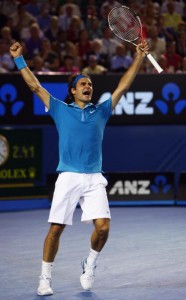Posted on
February 10, 2010 by
Claudia Celestial Girl
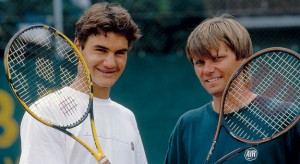
Federer, with his coach the late Peter Carter, was just beginning his rise to the top in 1999.
We are going to start a series of articles that outline the stand-out matches of Roger Federer’s career. The impetus of this series was a discussion of the Greatest Matches of the Decade – in which Roger was not mentioned very often. We thought that perhaps it was time to review some of the stand-outs. This article is the first of a series.
For this article I had to purchase the old match from 1999, and I must say, first I have to get a simple fan reaction out of the way. After all, these are three of the best looking men to ever step on a tennis court!
OMG! There’s Pat Rafter! In his heyday! There’s Lleyton Hewitt! Always one of my favorites. And there’s Roger Federer! He’s just a lad! It’s Rafter with the ponytail and Lleyton with a backwards baseball cap on. He was with the ponytail too. And Roger just has short hair (the Rafteresque ponytail would come later – see match with Sampras at Wimbledon in 2001.)
Roger’s neck is pencil thin. His face isn’t filled out. How cute he looks!
But the signs are there nonetheless. There is it right in the middle of the second set: a breathtaking backhand. The single-fisted backhand. Roger swings it for a lob that lands exactly in the corner. Perfect placement! How often would we see that again later!
Rafter, at 27 years of age, is in his prime. Rafter/Bjorkman are favored to win the match, and the commentators discuss how strange for the experienced pair to let youthful Hewitt and Federer get a set and a break on them, and take the first set to a tie-break.
Shortly after this Wimbledon appearance, Pat Rafter would be ranked #1 in the world (though he lost the singles’ semi-finals to Agassi). And that year, the pair of Rafter and Bjorkman had won the doubles titles at the Australian Open, Indian Wells, and Roger’s Cup. Read the rest of this entry →
Tags: doublesLleyton HewittPat RafterRoger FedererWimbledon
Category
Federer's Pillar Matches, General, Sports History, Tennis
Posted on
February 05, 2010 by
Claudia Celestial Girl
Here are some of the Pillar matches of Roger Federer’s career. Check back regularly to see stories on more of these great matches.
- Nadal vs Roger- 2004 Miami
-
Roger vs Agassi – 2004 US Open
-
Roger vs Roddick – 2004 WTF
-
Roger vs Safin – Tennis Masters Cup 2004
-
-
Roger vs Juan Carlos Ferrero – Dubai 2005
-
Roger vs Nadal – Miami 2005
-
Federer vs Santoro – New York 2005
-
-
Roger vs Nadal – Wimbledon 2007
-
Roger vs Roddick – New York 2007
-
Roger vs Tipsarevic – Australian Open 2008
-
-
Murray vs Roger 2008 – WTF Shanghai
-
-
Tags: Roger Federer
Category
Federer's Pillar Matches, Tennis
Posted on
January 31, 2010 by
Marianne Bevis
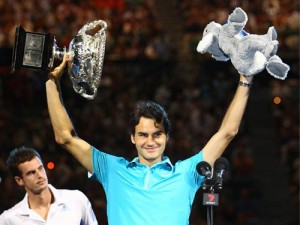
Andy Murray could do little but watch as Roger Federer claimed his 16th Grand Slam title.
Early Sunday morning, and the Great British public has risen early, as one, in the expectation of witnessing something special. It is the growing burden that Andy Murray has borne since he strode into battle in the Australian Open two weeks ago.
With every passing round, with each bigger foe put to the sword, the battle cries have grown.
Now, finally, the lights blaze over the perfect sweep of the Rod Laver arena and the crimson daylight subsides over the Melbourne skyline for the last time.
After two weeks of intense competition, it all comes down to this: Just two men standing.
They are the best that tennis has to offer on this last day of January. The three-time Australian champion, Roger
Federer, is attempting to hold off the aspiring first-time champion, Murray.
Federer has done it before, in the U.S. Open, but 18 months, many matches, sharper skills, and increased maturity have swelled the stature of the young Scot’s shoulders.
And there is something more. In the night sky beyond those spotlights, the stars seem to have shifted into alignment. This is Murray’s 17th Grand Slam in his 22nd year, the very number of Slams and years it took Federer to win his first title. Read the rest of this entry →
Tags: Andy MurrayAustralian OpenRoger Federer
Category
Australian Open, Tennis
Posted on
January 31, 2010 by
Claudia Celestial Girl
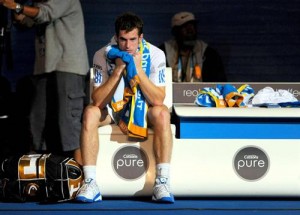
Andy Murray struggled in his second Grand Slam final against Roger Federer.
One Murray showed up to play Rafael Nadal on the Australian Open quarter finals in Melbourne this year. He came out on fire, pouncing on short balls, using his versatility on every shot, and playing ‘circus shots’ as soon as the chair umpire said ‘play.’ As if he knew that was what it took to get by a player with the talent of Rafael Nadal. And as if he was motivated to get beyond the quarter finals. As if he was the same age as the guy across the net, and just as good a player. This Andy Murray played without letup for two whole sets. Relentlessly aggressive, and respectful of what he was going to receive from the other side.
Another Murray showed up to start his semi-final match against Marin Cilic this year. Listless. Nervous. But when it looked like he was going to be out of the tournament, he came to life. The ‘other’ Murray manifested!
Let’s invent an avatar for this other Murray, and call him William Wallace Murray. We even have a visual to to with the avatar – it is the roaring face of Andy Murray at break point in the second set of the Cilic match! With face painted blue!
The second Murray showed up to play the final against Roger Federer. We can invent an avatar for this player too. We could call him Bonnie Prince Charlie – Murray, but that would be cruel. OK, let’s be cruel. There’s a visual to go with this avatar too. I can picture it now, a moment in 2008 at the Roger’s Cup in Toronto against Rafael Nadal, when he missed a put away and slammed his racket to the ground and made a mock barfing face. Or we could use one from this final: a grimace as he missed, yet again, one of his famous forehands down the line , one that he makes all the time on other, less momentous, occasions.
BPC-Murray (let’s shorten it) is not a total disaster. Against players outside of the top ten, BPC-Murray is crafty, capable, confident, in control. A great example of the efficacy of this Murray is his play against American John Isner in the 4th round. Even an American football player, visiting in the stands, could perceive the scary, deliberate, craftiness of this Murray as he probed and found the weaknesses of Isner, and then cruelly (and beautifully) wrapped him up, like spider with a fly. Read the rest of this entry →
Tags: Andy MurrayAustralian OpenAustralian Open final MurrayRoger Federer
Category
Australian Open, Tennis
Posted on
January 26, 2010 by
Marianne Bevis
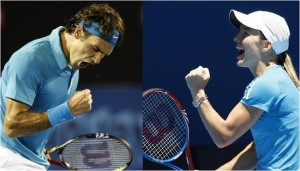
Roger Federer and Justine Henin have been sporting similar colors and similar emotions during the Australian Open.
It was the first weekend of June 2009, and little more than a year after her dramatic retirement from tennis.
Justine Henin did not watch the women’s event at Roland Garros, for she had little interest in who would win the title she had refused to defend in 2008.
She did, though, watch the men’s tournament: “I feel closer to players like Roger Federer. And, of course, Roger was trying to win the only Grand Slam he had never won. Part of me wanted him to win but, in another way, I knew it would give me trouble mentally if he did.”
For like her male doppelganger, Henin had several times come within a whisker of winning the one Slam she was missing.
Her “trouble” was Wimbledon. If Federer—like her in so many ways—could scale his final mountain at the French Open, maybe she too could scale hers at Wimbledon. After all, Federer was in his 28th year and, in 2010, she would be too.
“You know that little voice we all have in our heads…it was telling me Roger winning the French was very special…it made me think how much I’d missed by not winning Wimbledon.”
That little voice bothered her so much that it made her pick up her racket. It then made her, three months later, announce her comeback to the Tour. Read the rest of this entry →
Tags: Australian OpenJustine HeninRoger Federer
Category
Australian Open, Tennis
Posted on
January 15, 2010 by
Rajat Jain
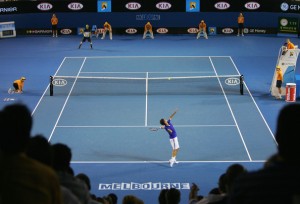
The 2010 Australian Open begins on Monday, January 18th.
In tennis, the offseason between the outgoing year’s World Tour Finals (or the previous other names by which the year’s final ATP tournament was called) and the upcoming year’s first tournament is never too long.
It seems even shorter in the last few years with the advent of the Internet, which meant increased participation by fans; it went like a blitz this year as the decade came to a close. Pages worth of analysis were written, and tons of best and worst lists were formed, discussed, and argued upon.
In no time, Christmas and New Year’s Eve passed by…and suddenly Nikolay Davydenko had defeated Roger Federer and Rafael Nadal on back-to-back days, Robin Soderling got the 13th time luck against Federer (albeit in an exhibition match), Justine Henin and Kim Clijsters played a nerve-wracking thriller that was absent almost all of the last year in the WTA circuit, and—lo!—the draws of the year’s (rather, decade’s) first major have been released.
Australia, the Land Down Under, may be thinly populated, but it is probably the most dominant country in sports. Be it cricket, rugby, hockey, or football, they can teach the world a thing or two in each sport. In tennis, they boast of an unparalleled legacy. With legends like Rod Laver, John Newcombe, Ken Rosewall, and Roy Emerson, to name a few, they have fielded some of the finest tennis players ever to grace the game.
But despite this fine sporting history, their native Grand Slam tournament took time to establish itself. The Australian Open was constantly in a state of flux after the Aussie legends faded down the scene. Read the rest of this entry →
Tags: Australian OpenRafael NadalRoger Federer
Category
Australian Open, General, Tennis

